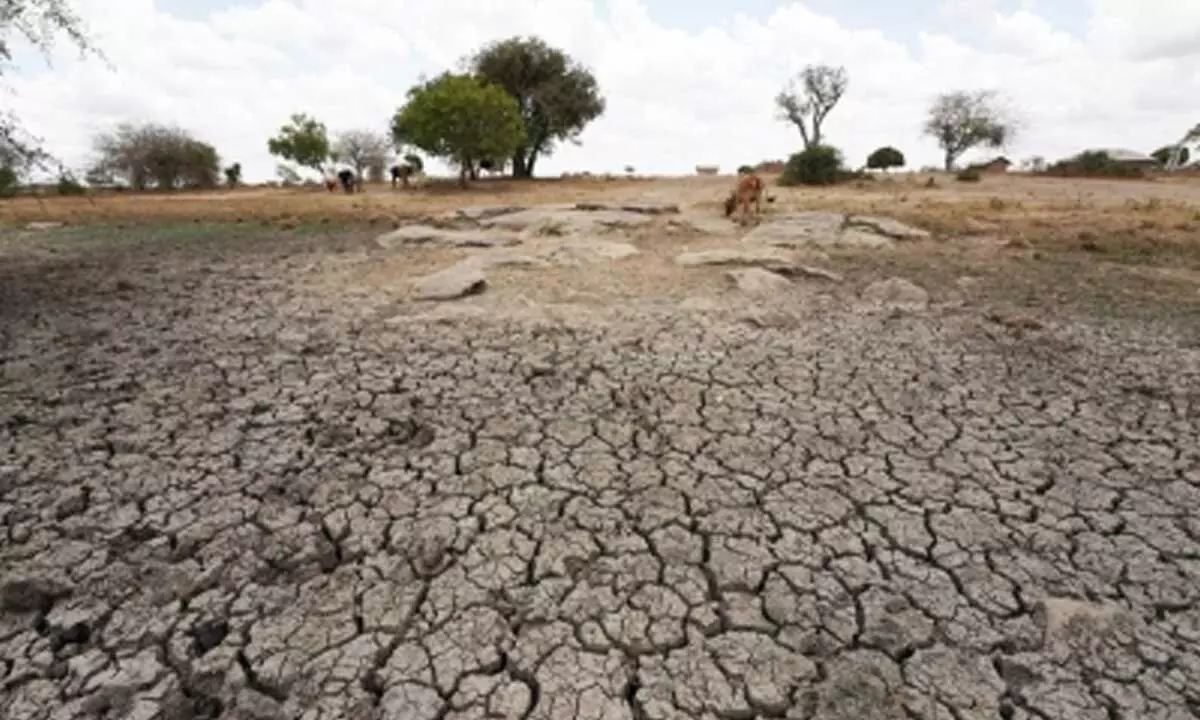Live
- 13 killed, 18 injured as landslides, flash floods hit Indonesia's North Sumatra province
- Israeli PM seeks additional delay of testimony in court for criminal trial
- JAIN International Residential School, Bengaluru jointly with The Sports School to announce India’s First Integrated Scholarship Future25
- Sale certificate issued in pursuance to a court's auction not required to be stamped: Supreme Court
- Andhra Pradesh: Jagan flays Chandrababu-led govt for neglect of education
- Sri Lanka issues flood warnings for 12 flood-prone river basin areas
- IPL 2025 Auction: Venkatesh Iyer sold to KKR for Rs 23.75 cr, Stoinis joins PBKS for Rs 11 crore
- Kharge to lead Opposition strategy meeting as Parliament session kicks off on Monday
- Three killed in firing as violence breaks out amid Sambhal mosque survey in UP
- IPL 2025 Auction: Ravichandran Ashwin, Rachin Ravindra return to Chennai Super Kings
Just In
Climate change deadlier than cancer in some areas: UNDP


For representational purpose
Climate change could be twice as deadly as cancer in some parts of the world if carbon emissions remain high, according to new data released by the UN Development Programme (UNDP) and the Climate Impact Lab.
United States: Climate change could be twice as deadly as cancer in some parts of the world if carbon emissions remain high, according to new data released by the UN Development Programme (UNDP) and the Climate Impact Lab.
Using Dhaka, Bangladesh, as an example, according to the data released on Friday, additional deaths from climate change would be nearly twice the country's current all-cancer death rate and 10 times its road traffic death rate by 2100, reports Xinhua news agency.
"Because of human action, the concentration of carbon dioxide in our atmosphere is reaching dangerous levels, driving earth's temperatures higher and amplifying the frequency of intensity of extreme events," says the newly launched Human Climate Horizons platform, adding that without concerted and urgent action, climate change will further exacerbate inequalities, and uneven development.
In addition to the analyses from the Human Development Reports of 2020, 2021, and 2022, the data shows how climate change impacts people's lives -- from mortality to livelihoods.
Higher temperatures and a warmer climate stress cardiovascular and respiratory systems around the world, but the effects will differ depending on how well communities are equipped to adapt.
According to the data, climate change could lead to nearly 67 deaths per 100,000 population in Faisalabad, Pakistan -- more deaths than strokes, the third leading cause of death.
Despite higher incomes in Riyadh, Saudi Arabia, the death rate is still higher than Alzheimer's disease, which is the sixth leading cause of death worldwide.
According to the research, the earth's average temperature has risen by nearly 1.2 degrees Celsius since the late 19th century, changing the entire planet's surface.
Nevertheless, billions live in regions that have already experienced warmer temperatures than the global average.
As an example, the platform points to Maracaibo, Venezuela, noting that in the 1990s it averaged 62 annual days with temperatures exceeding 35 degrees Celsius. However, by mid-century, that number will likely soar to 201 days.
Electricity availability and fuels used to generate it to power air conditioners and heaters play a crucial role in our ability to cope with extreme temperatures, according to the UNDP.
As individuals, communities, and businesses adapt to changing conditions, the effects of climate change on energy use will vary locally.
In Jakarta, for example, electricity consumption in response to warmer temperatures is projected to increase by roughly one-third of current household consumption in Indonesia. This will require critical additional infrastructure planning.
Increasingly frequent and severe temperature extremes also threaten livelihoods, affecting work intensity and duration as well as affecting the ability to perform tasks.
"The impact of climate change differs across sectors of the economy with workers in high-risk, weather-exposed industries like agriculture, construction, mining and manufacturing most affected," according to platform data.
In Niamey, Niger, in sectors such as construction, mining and manufacturing, excessive heat was responsible for 36 fewer working hours annually, taking a 2.5 percent toll on the country's future GDP.
In Niger, as in many other parts of the Sahel, climate shocks have resulted in recurring droughts with devastating impacts on the region's already vulnerable populations.
Climate change impacts are not evenly distributed globally, which will result in an increase in inequalities.
The UNDP hopes that by highlighting that the future is not predetermined, people can step up climate action everywhere.
Meanwhile, the UNDP has also launched the How Just Transition Can Deliver the Paris Agreement report this week, highlighting the need to embrace the "green revolution" -- or risk increasing social inequality, civil unrest, economic loss.
Ahead of the UN climate conference, COP27, which kicks off on Sunday in Sharm el-Sheikh, Egypt, the report spotlights the importance of "fair and equitable" transitioning to meeting the climate goals set out in the Paris Agreement.
From providing workers with new green economy skills and access to social protection to ensuring that countries lay out a clear pathway to a net-zero future, UNDP chief Achim Steiner said the report provides "real-world insights into how to accelerate momentum around a just transition that is fair and equitable for the energy sector and beyond".

© 2024 Hyderabad Media House Limited/The Hans India. All rights reserved. Powered by hocalwire.com






